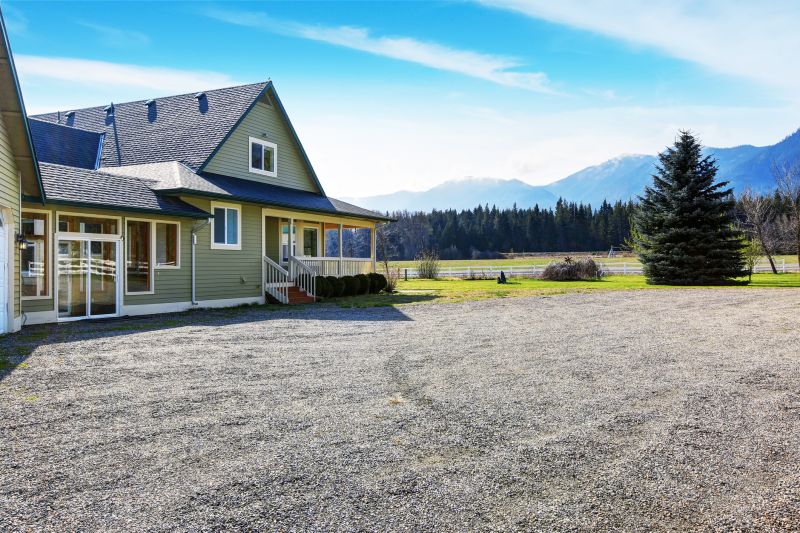Favorite Tools and Materials For Gravel Base Setup
Get the essential products trusted by professionals to create a solid foundation for pathways, driveways, and more.
 Constructing a stable gravel base is a fundamental step in many outdoor projects, including pathways, driveways, and patios. The success of these installations largely depends on selecting the right products to create a durable, well-draining foundation. Various materials and tools are available to facilitate proper gravel base preparation, each serving specific functions such as compaction, stabilization, and leveling. Understanding the different product options can help ensure that your project achieves long-lasting results.
Constructing a stable gravel base is a fundamental step in many outdoor projects, including pathways, driveways, and patios. The success of these installations largely depends on selecting the right products to create a durable, well-draining foundation. Various materials and tools are available to facilitate proper gravel base preparation, each serving specific functions such as compaction, stabilization, and leveling. Understanding the different product options can help ensure that your project achieves long-lasting results.
Top Overall Option
Geotextile Fabric for Gravel Stabilization
A high-quality geotextile fabric serves as a foundational layer that stabilizes gravel bases by preventing soil mixing and enhancing load distribution. It is versatile and suitable for various applications, providing long-term stability and drainage support, making it a reliable choice for many gravel installation projects.
Types of Products For Gravel Base Installations
Crushed Stone and Gravel Mixes
Various crushed stone blends provide a stable, permeable base layer suitable for driveways and pathways.
Compaction Equipment
Vibratory plates and rammers help compact gravel layers to increase stability and reduce settling.
Geotextile Fabrics
Synthetic fabrics that reinforce gravel layers and prevent soil migration, enhancing durability.
Edge Restraints
Plastic or metal borders that contain gravel and maintain the shape of the installation.
Leveling Tools
Rakes, screeds, and laser levels assist in achieving an even surface during installation.
Drainage Pipes and Gravel
Perforated pipes combined with gravel help manage water runoff and prevent pooling.
Sand and Fine Gravel
Used as a bedding layer or for fine leveling before adding larger gravel.
Landscape Fabric
Non-woven fabrics used beneath gravel to prevent weed growth and soil mixing.
Watering and Compacting Accessories
Tools like watering cans and tamper plates assist in proper compaction and moisture control.
Bedding Material
Crushed stone or sand used as a base layer to improve stability and drainage.
Hand Tamps and Mechanical Compactors
Tools used to manually or mechanically compact gravel layers for increased stability.
Pickup and Delivery Gravel Bags
Pre-packaged gravel options for small or quick projects, offering convenience.
Geogrids
Reinforcement grids that distribute loads and improve gravel base strength.
Edge Anchors
Devices that secure edge restraints and prevent movement over time.
Leveling Rakes
Tools designed specifically for spreading and leveling gravel evenly.
Vibratory Rollers
Heavy machinery that compacts large gravel layers efficiently for large-scale projects.
Popular Choices
Widely used for creating stable and permeable driveway surfaces suitable for various vehicles.
Commonly chosen for their effectiveness in compacting gravel and soil in small to medium projects.
Popular for providing separation and reinforcement in gravel base layers.
Frequently used to contain gravel and maintain clean edges in installations.
Essential tools for achieving an even surface during gravel spreading.
Commonly integrated with gravel beds to improve water drainage in large projects.
Popular for bedding layers and fine leveling before laying larger gravel.
Chosen for weed suppression and soil separation beneath gravel surfaces.
Frequently used for small-scale projects requiring manual compaction.
Increasingly selected for high-traffic or load-bearing gravel surfaces.
Convenient for quick projects, offering large quantities of gravel in manageable packages.
Popular for their efficiency in compacting large areas of gravel quickly.
Favored for projects requiring effective water runoff management.
Commonly used to secure borders and prevent gravel spreading.
Preferred for large-scale, heavy-duty gravel compaction tasks.
When choosing products for gravel base installations, it is important to consider factors such as soil type, load requirements, and the intended use of the finished surface. Properly prepared gravel bases can improve drainage, reduce shifting, and enhance overall stability. Using quality materials and appropriate tools can also make the installation process more efficient and less labor-intensive.
In addition to selecting the right gravel and compaction equipment, accessories like geotextile fabrics and edge restraints can significantly influence the integrity of the base layer. Geotextile fabrics help prevent mixing of the gravel with underlying soil, maintaining the structure's stability over time. Edge restraints keep the gravel contained and prevent spreading, which is essential for maintaining a clean, professional appearance.
Ultimately, investing in the right products for gravel base installation can contribute to a successful project that withstands the test of time and weather. Careful planning and the right tools and materials are key to creating a solid foundation for any outdoor surface. Whether for a small pathway or a large driveway, selecting appropriate products tailored to your specific needs will help ensure a smooth installation process and a durable finished product.
Key Buying Considerations
- Project size and scope to determine the quantity of materials needed.
- Type of soil and subgrade conditions affecting material choice.
- Intended load-bearing capacity and traffic level on the finished surface.
- Drainage requirements to prevent water pooling and erosion.
- Compatibility of materials with existing landscape or structures.
- Ease of installation and availability of tools or machinery.
- Durability and longevity of the selected products.
- Budget constraints and cost-effectiveness of materials.
- Environmental factors such as moisture levels and freeze-thaw cycles.
- Ease of maintenance and future repair needs.
- Compatibility of geotextile fabrics with gravel and soil types.
- Edge containment options to prevent gravel migration.
- Local regulations or standards that may influence material selection.
- Availability of professional assistance or DIY suitability.
- Safety considerations during installation, especially when using machinery.
This content may contain affiliate links. We may earn a commission if you purchase through these links, at no additional cost to you. Our goal is to provide helpful and unbiased information to assist your project decisions.
